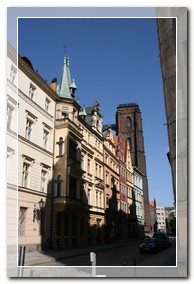


 he location between the streets Szewska and Łaciarska did not bring luck to the two churches built there in sequence. The first one was destroyed during the Mongolian invasion in 1241. The second, built in the years 1242–1248, was burnt in May 1342. Just the late-gothic church raised in the years 1342–1362 which towers joined with a bridge can be admired from the present Market square, lasted to our times. Lack of luck, it also burnt in 1887 during the fireworks demonstration, and then in the time of the World War II. Additionally soon after finishing the warfare the southern tower was torn apart by the explosion of a mine.
he location between the streets Szewska and Łaciarska did not bring luck to the two churches built there in sequence. The first one was destroyed during the Mongolian invasion in 1241. The second, built in the years 1242–1248, was burnt in May 1342. Just the late-gothic church raised in the years 1342–1362 which towers joined with a bridge can be admired from the present Market square, lasted to our times. Lack of luck, it also burnt in 1887 during the fireworks demonstration, and then in the time of the World War II. Additionally soon after finishing the warfare the southern tower was torn apart by the explosion of a mine.
Initially, it fulfilled next to the saint Elizabeth church the function of a municipal Parish church. In 1523, thanks to the efforts of Johann Hess, it became a protestant church. At present it is the cathedral of a diocese of Wroclaw's Polish-Catholic church.
Between the towers of the church, on the height of 45 m, a platform was hung. It is called by the citizens of Wroclaw the witches bridge.
 According to folk stories every night it is swept by the souls of vain girls, who digested their lives on parties, refusing their hand to all adorers because of the reluctance to home duties.
According to folk stories every night it is swept by the souls of vain girls, who digested their lives on parties, refusing their hand to all adorers because of the reluctance to home duties.
A different story connected with this church concerns the Sinner Bell, a six tone giant, high on 1,8 m, about the circuit of almost 6,5 m, which needed 30 seconds of efforts of four bell-ringers to make it swing. It was hung on the southern tower of the church in 1368, and it was destroyed in 1945, after the conquest of Wroclaw, when the tower carrying it collapsed after the explosion of a mine. Initially it was supposed to be named Maria, however because of bloody events connected to its birth it was after all named the Sinner Bell. The legend says that the municipality ordered it from the best bell-founder in the city, master Michael Wilde. It was a difficult art to cast such a giant and master Wilde had only one chance; if it did not succeed, he would have to begin the whole work from the beginning. When he prepared the form and mixed in the crucible copper, tin, zinc and lead, he went to a nearby pub to dine, and maybe to drink a cup or two for courage. He commanded his journeyman to watch the fire under the crucible with the melted bronze, but not to touch anything else. However the youngster because of his stupidity or carelessness unlocked the valve by playing with the crucible and the hot metal poured into the form. When the master found out what happened, in an attack of madness he stabbed his journeyman with a knife. Although he regretted his act sincerely, the city council sentenced him to death. It was successful for him, though, to prevail so that he could hear his bell in the day of his death. It sounded beautifully, when the convict was being lead on his execution and from this day, it sounded every time when an execution was being made in the city.
From the south side, on the side of the church, we can admire a beautifully adorned Romanesque portal from the abbatial church on Ołbin, transferred to Wrocław in 1546. The famous monastery of saint Vincent on Ołbin was destroyed in 1529 on the recommendation of the municipal counsel, because with it's defenses and size it made up the counterweight for the centre of Wroclaw. Only this portal was left after it, even the tombs of the founders of the monastery, Peter and Maria Włostowic, were profaned during the demolition.






